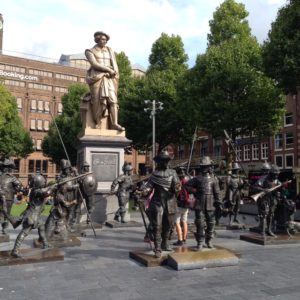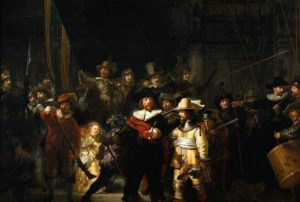Amsterdam may have as many interesting sights per square mile as any city on earth.
From 50-some museums, to the canals, the architecture, the flower market, the zoo … something interesting is just a few minutes walk away.
The most famous of the museums is the Rijksmuseum, which houses Rembrandt‘s The Night Watch, among hundreds of works by the Dutch masters.
And in the case of The Night Watch, you get to see it twice. Once on canvas, once in cast bronze.
Rembrandt finished painting The Night Watch in 1642, and it was considered a masterpiece pretty much from when it was first seen.
In it, Rembrandt took painting forward by portraying the characters in such a way that they seem almost to be moving. His use of light and shadow also was ahead of its time, with light drawing the eye to the most important figures in the painting.
To see it, you buy a ticket to the Rijksmuseum, which is near the center of the city, go to the second floor and pass through the “Hall of Legends”, exiting on the north side, where Rembrandt’s near-life-size painting is hanging.
We were there on a day when the museum was not overrun by tourists, so we had little trouble walking up to the rope keeping viewers from getting too close to the painting. (There have been incidents of vandalism.)
It is remarkable to look at; it is easy to spend a big chunk of time just working through the characters.
In 2009, The Night Watch got a further boost in popularity when a pair of Russian artists produced bronze statues of most of the characters crowded into Rembrandt’s painting.
The statues are located in Rembrandplein, not far from the Rijksmuseum, and they bring even greater understanding to the painting.
The statues are placed in such a way that the 3D/depth Rembrandt was giving his painting becomes easier to understand — because the statues are not bumping each other. Instead they have been caught in poses that place them in a greater space, seeming to emphasize each individually.
The bronze statues of the militiamen seems to reinforce the popularity of the painting, even as it serves as an increasingly important tourist attraction in its own right.
We sat in the square for a stretch, watching people interacting with the painting.
Posing for photos and selfies between the two officers front-and-center in the painting has become de rigueur for tourists, particularly the college-age kids who seem to gather at the square.
This double-barreled exposure seems to reinforce the popularity of the painting, and the synergy between them is still new.
The statues were completed in 2009, and set up in the Rembradtplein in 2012. Meanwhile, the Rijksmuseum, which had been in renovation for a decade, was re-opened in 2013.
Something else to do in Amsterdam … not that we were suffering from a lack of choices.



0 responses so far ↓
There are no comments yet...Kick things off by filling out the form below.
Leave a Comment